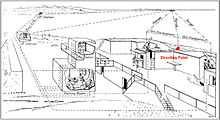Directing point


Often the DP was taken as the pintle center[2] of the right-most gun in a battery, as an observer looked over the battery towards the sea. In this case, the referenced gun was called the directing gun.
In a two-gun battery, the DP was often located at a point midway between the two guns (as in the battery illustrated at right). In a four-gun battery, the DP was often located midway between the two central guns. When the guns of a battery were more widely separated, the DP was often taken as a point on the ground perhaps 50 to 100 feet in front of the guns and more or less at the midpoint of the horizontal extent of the battery, visible from all of its guns. An example of such a directing point can be found at Fort Strong, a Coast Artillery fort on Long Island in Boston Harbor (42°19′48″N 70°57′20″W / 42.330081°N 70.95554°W).[3]

Often a target, for example a vertical wooden sighting panel (or a sighting pole, not unlike a surveyor's target rod) was placed precisely over the DP marker so that the guns of the battery could sight on it and adjust the offsets of their gun sights.
If the guns of a battery were widely separated, the firing data, computed for the DP, might have had to be corrected in azimuth for the various guns.[4] These calculations could be performed in the plotting room and telephoned to the battery or be performed at the guns. If the guns were relatively close to each other, then it might be enough to point them all at the same azimuth, to fire a salvo in parallel with each other.
References
- ↑ See for example "FM 4-15: Coast Artillery Field Manual, Seacoast Artillery, Fire Control and Position Finding," U.S. Government Printing Office, Washington, 1943, p. 20 ff.
- ↑ The pintle center was the center of the gun pivot, mount point, or center of gravity of a gun.
- ↑ The green arrow placed by Google Maps in its Satellite view is located about 100-300 ft. in front of the (now empty) various gun positions of Batteries Ward and Hitchcock of Fort Strong, which mounted 10-inch disappearing guns from about 1905 until the 1930s. This position, marked by a disk labeled FORT STRONG USE 1934, was precisely surveyed by the U.S. Army Engineers in 1934, and although it is not specifically identified as a directing point, there would have been little reason for the mark otherwise. The mark itself remained hidden up through 2010, but may still be in place. A description of the disk and its coordinates are contained here.
- ↑ Supra, Note 1, at para. 28 ff. Since the azimuths and distances of the guns one from another were known, triangulation could be used to figure out the necessary aiming azimuths for each gun.